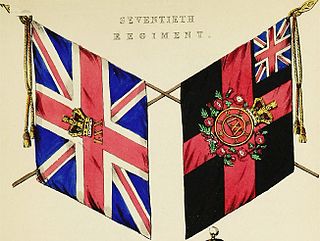
George Waldegrave, 4th Earl Waldegrave, PC was a British Army officer and politician who sat in the British House of Commons from 1774 to 1780.

The 72nd Highlanders was a British Army Highland Infantry Regiment of the Line. Raised in 1778, it was originally numbered 78th, before being redesignated the 72nd in 1786. Under the Childers Reforms it amalgamated with the 78th (Highlanders) Regiment to form the 1st Battalion of the Seaforth Highlanders in 1881.
The 65th Regiment of Foot was an infantry regiment of the British Army, raised in 1756 as the 2nd Battalion, 12th Regiment of Foot. Under the Childers Reforms it amalgamated with the 84th Regiment of Foot to become the 1st Battalion, York and Lancaster Regiment in 1881.

The 70th (Surrey) Regiment of Foot was a regiment of the British Army, raised in 1756. Under the Childers Reforms it amalgamated with the 31st (Huntingdonshire) Regiment of Foot to form the East Surrey Regiment in 1881.
The 37th Regiment of Foot was a line infantry regiment of the British Army, raised in Ireland in February 1702. Under the Childers Reforms it amalgamated with the 67th Regiment of Foot to become the Hampshire Regiment in 1881.

The 39th (Dorsetshire) Regiment of Foot was an infantry regiment of the British Army, raised in 1702. Under the Childers Reforms it amalgamated with the 54th Regiment of Foot to form the Dorsetshire Regiment in 1881.
The 61st Regiment of Foot was an infantry regiment of the British Army, raised in 1756. Under the Childers Reforms it amalgamated with the 28th Regiment of Foot to form the Gloucestershire Regiment in 1881.
The 64th Regiment of Foot was an infantry regiment of the British Army. The regiment was created as the 2nd Battalion, 11th Regiment of Foot in 1756, redesignated as the 64th Regiment of Foot in 1758, and took a county title as the 64th Regiment of Foot in 1782. Following the Cardwell Reforms the regiment amalgamated with the 98th Regiment of Foot to become The Prince of Wales's in 1881. In the new regiment the 64th Foot became the 1st Battalion due to its seniority over the 98th Foot.
The 48th (Northamptonshire) Regiment of Foot was a regiment of the British Army, raised in 1741. Under the Childers Reforms it amalgamated with the 58th (Rutlandshire) Regiment of Foot to form the Northamptonshire Regiment in 1881.
The 58th (Rutlandshire) Regiment of Foot was a British Army line infantry regiment, raised in 1755. Under the Childers Reforms it amalgamated with the 48th (Northamptonshire) Regiment of Foot to form the Northamptonshire Regiment in 1881.
The 71st Regiment of Foot was a British Army regiment of infantry raised in 1775, during the American Revolutionary War and unofficially known as Fraser's Highlanders. It was disbanded in 1786.
Washington's aides-de-camp during the American Revolutionary War were officers of the Continental Army appointed to serve on General George Washington's headquarters staff, with the rank of lieutenant colonel. The headquarters staff also included one military secretary, a full colonel.

The 49th (Hertfordshire) Regiment of Foot was a line infantry regiment of the British Army, raised in 1743. Under the Childers Reforms it amalgamated with the 66th (Berkshire) Regiment of Foot to form the Princess Charlotte of Wales's in 1881.
General George Morrison was Quartermaster-General to the Forces.
The 74th Regiment of (Highland) Foot or 74th Regiment of Foot (Argylshire Highlanders) was a British Army line infantry regiment from 1777 to 1784 which was raised to fight in the American Revolutionary War.
The 80th Regiment of Foot (Royal Edinburgh Volunteers) was a regiment in the British Army from 1778 to 1783.
The 85th Regiment of Foot (Westminster Volunteers) was a short-lived infantry Regiment in the British Army which was raised in 1777 to provide garrison troops for the West Indies during the American Revolutionary War.




